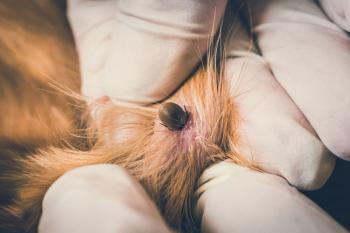
- dvm360 October 2023
- Volume 54
- Issue 10
- Pages: 36
Five steps for low-stress feline care
Handling cats can present serious safety risks to both the patient and the staff handlers, but an effective strategy with the right tools can prevent injury
Many small animal practices have a range of personnel with different experience levels handling feline patients. Meeting clinical demands and training additional technicians create difficulty in finding time to ensure the staff develops low-stress handling skills and success- fully implements them. This can result in increased instances of injury, burnout, and staff turnover. Get back to the basics for meaningful, low-stress feline care with just 5 steps to help achieve the best possible experience for staff, clients, and patients.
1. Stock your feline toolbox
Educating your staff on the basics of low-stress care starts with understanding body language, common anxiety triggers, and how memories are embedded in your feline patients. Cats have a range of body language from normal behaviors to behaviors that indicate varying levels of stress. Recognizing the signs of stress in a patient as well as the triggers that can cause stress are the first steps in de-escalating a situation. Every aspect of the cat’s handling, environment, and travel can be potential a trigger that embeds the memory of fear, so minimizing stress at every stage of care is important.
There are several resources available for veterinarians to review with staff
and keep on hand as a reference. The Feline Ladder of Aggression (Figure 1) and a body language chart by low-stress handling expert Sophia Yin, DVM, MS,1 are available online. Additionally, veterinarians caring for felines should stock examination rooms with towels, cat wraps, and pheromone spray. Teaching employees specific techniques from one of the veterinary certification programs or webinars regarding less stressful handling can also be invaluable. Once tools are in place and available, they should be used every day, with every cat.
2. Have a game plan
Having the right tools is more effective when partnered with the proper care techniques all the way through the visit. Cats are at their best in a calm environment. Have clients wait in their car to avoid meeting up with dogs or loud individuals in the waiting area. Keep cats in carriers covered by a towel. Use examination areas that are away from other animals, loud individuals, and traffic noise; and stay in the examination room rather than going to the treatment area. Veterinarians can also ask clients to keep cats in a bathroom to avoid giving them a chance to hide.
Touch is stimulating to most cats. When possible, avoid petting, tightly holding, or putting hands on the cat. Many mature cats have arthritis or dental or intestinal inflammation, all of which increase sensitivity to touch and pain. This can be difficult when giving an injection or examination, so tools such as gloves (Figure 2), towels, and cat wraps can help insulate against the sensation of touch. Many cats are calmer when tools are used before any anxiety escalation and with rewards. This can sometimes even reduce or eradicate the need for gloves, wraps, muzzles, and sedation.
“Cats escalate quickly and calm slowly,” Surell Levine, VMD, developer of the Calm & Cozy Cat Wrap, a swaddle-like wrap designed with access points to apply calming broad pressure without restricting care capabilities, said. “With the limited staff we’re seeing across the industry, treating anxious cats without sedation or a calming tool is nearly impossible. These situations can also cause both mental and physical harm to staff.”
Providing a buffer between a cat and direct touch protects staff in the event aggression is triggered. This allows staff to relax, which the cat senses, and the visit can proceed at a lower level of stress for all involved.
With lower stress levels, a big part of the care puzzle can be realized when better diagnostic data can be obtained. In a 2021 study, clinical parameters and the behavior of 95 cats during veterinary examinations were analyzed.2 Eighty-five percent of the cats demonstrated a heart rate higher than normal. Overall, results showed that veterinary examinations and possibly travel to appointments lead to tachycardia, mydriasis, and behavior and body movements associated with fear and aggression.2
Less-stressed felines yield more accurate data points. By avoiding stressors that increase blood pressure readings (Figure 3), which in turn catalyze increases in cortisol, a true picture of a cat’s health status is allowed to emerge and be recorded for more accurate historical monitoring.
Simple techniques and tools to calm cats can elicit more reliable data in feline care. “Applying uniform, constant, and deep pressure around a cat’s body, which has been shown to relax muscle tone and decrease blood pressure, heart rate, and basal metabolic rate, makes lab data easier to obtain and results more accurate,” Levine said.
3. Make low-stress care a team effort
The veterinary team members are not the only ones who can help an examination go smoothly. Clients can take certain steps at home and on the way to the clinic to help decrease risk. Advise clients to encourage calm travel and smooth arrival with the following tips that can help start the examination off right: Use pheromone spray on bandanas for cats to wear before travel, train their pets to like the carrier as well as any towel or wraps, and use supplements or medications to decrease anxiety, pain, and sensitivity to touch and noise.
Client communication is key. Partner with clients by also demonstrating low-stress care techniques that work for individual pets. Clients can also benefit from a copy of the low-stress handling techniques used by the veterinarian to help a cat accept care. When clients use these skills successfully at home, it reinforces the positive experience and creates a cooperative cat for care. Veterinarians can further help clients handle their cat safely by providing cat wraps, towels, and gloves that are comfortable for the cat and the owner.
Even the best-behaved cat may give a stray scratch or nick a hand with a tooth. Set clients and their cats up for success with specific handling plans, demonstrations of handling techniques, and tools to handle them safely (Figure 4).
4. Mitigate the risks
Intentional or not, cat bites are very serious. They present a special risk for infection. A cat’s sharp canine teeth penetrate quickly, delivering bacteria deep into the tendons of the hands and arms. Deep infections often develop with fever and swollen, inflamed tissue requiring medical care. Although cat bites are far less frequent than dog bites, 75% of infected animal bites are from cats. Of those with infected bites, 70% develop swelling, fever, and deep infection within 24 hours and 90% develop these symptoms within 48 hours.3 One in 3 infected cat bites results in hospitalization.4 No matter how adept staff are at low-stress care, bite risk still exists. A patient lashing out in pain, accidental nips when handling the head, or cats conditioned to bite at hands in play are all common scenarios that could easily result in a bite. Less experienced staff will be at a higher risk for bites because they are not as skilled in reading body language, using safety tools, or thinking preemptively about anxiety and pain-relieving medications. Another risk factor to take into consideration is staff members who are pregnant or are post pregnancy. This is not a time to take a risk on a bite, yet it is not unusual for staff to forgo using safety tools even for employees at a higher risk, feeling that would label the animal or somehow be more stressful.
In many cases, care cannot wait for a staff member at lower risk to be available. Rescheduling or delaying care may increase the harm of illness or injury. Also, a client may not be able to afford the time and cost of a delayed appointment. In these situations, reducing stress and using tools in a low-stress manner strike a balance between providing necessary care and managing risk. Practice is never perfect; balancing the needs of the patient, the staff, and the client is a daily dance. However, using low-stress care techniques can help provide that balance and keep everyone involved in a cat’s visit safe.
5. Stick the landing
Ending the examination on a calm note on the table or in the car area decreases the cat’s embedded memory of stress. Remember that the last memory is the lasting memory. Use rewards after you have given an injection or complete an examination for further positive reinforcement. Take time to be present as the cat calms while recording the handling plan for any potential staff treating this cat in future visits. Adherence to the handling plan and all other steps for low-stress care increase pet cooperation and protect everyone involved.
Sally Foote, DVM, CABC-IAABC, LSHC-S, FFE, is a veterinary behavior consultant, writer, and creator of the Bella Behavior Medical Record System. With more than 35 years of general practice experience and a special interest in behavior, Foote has created content for the general practitioner integrating the techniques of low-stress care with pain management, staff safety, and efficiency. Foote also hosts workshops at the Bella Behavior Learning Center and Veterinary Learning Lab in Tuscola, Illinois.
References
- Yin S. Low-stress handling resources from Cattle Dog Publishing. Cattle Dog Publishing. February 19, 2009. Accessed September 13,
2023. https://cattledogpublishing.com/blog/ low-stress-handling-resources-from-cattledog-publishing/ - Tateo A, Zappaterra M, Covella A, Padalino B. Factors influencing stress and fear-related behaviour of cats during veterinary examinations. Ital J Anim Sci. 2021;20(1):46-58. doi:10.1080/1828051X.2020.1870175
- Dimcic T, Gregoric M, Breznik V. Rapidly progressive infection of hand after a cat bite. Cureus. 2020;12(7):e9357. doi:10.7759/cureus.9357
- Theimer S. When cats bite: 1 in 3 patients bitten in hand hospitalized, infections common. Mayo Clinic. February 5, 2014. Accessed September 13, 2023. https://newsnetwork. mayoclinic.org/discussion/when-cats-bite-1-in-3-patients- bitten-in-hand-hospitalized-infections-common/
Articles in this issue
about 2 years ago
Nephrosplenic space ablation in horsesabout 2 years ago
Preventing mushroom toxicosis in our companion animalsabout 2 years ago
Driven by dataabout 2 years ago
We are veterinarians, not vaccinarians—how wellness is perceivedabout 2 years ago
Theriogenology in veterinary medicineabout 2 years ago
Do you have the right to remain silent?about 2 years ago
CPMA: The first antiviral canine parvovirus treatmentNewsletter
From exam room tips to practice management insights, get trusted veterinary news delivered straight to your inbox—subscribe to dvm360.




